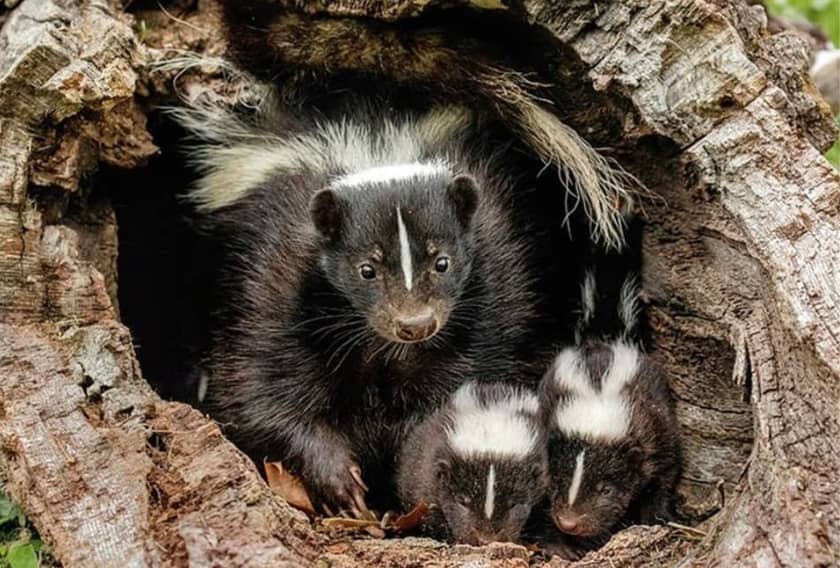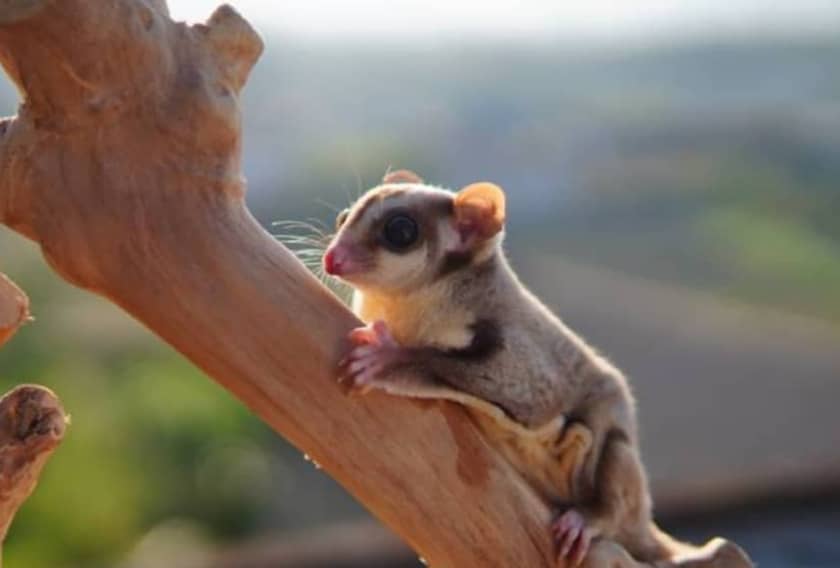The Southern Flying Squirrel, also known as the “Assapan,” is a small, nocturnal rodent found in North America. It is distributed in deciduous and mixed forests over the eastern half of North America, from southeastern Canada to Florida.
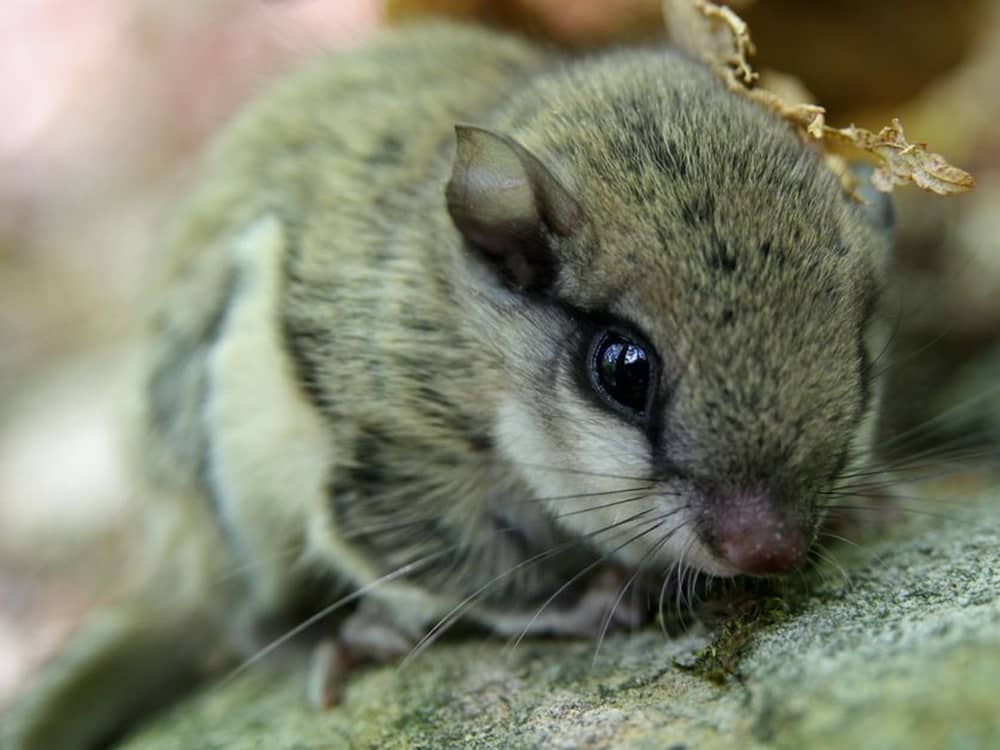
They have gray-brown fur on top with darker flanks and are cream underneath. They have huge, black eyes and flat tails. Flying squirrels do not fly, but glide. They have a hairy membrane termed a ‘Patagium’ that runs between their front and back legs.
Glaucomys volans is the scientific name of the southern flying squirrel. Flying squirrels consume fruit and nuts from red and white oak, hickory, and beech. They store food for winter consumption. They consume fruit and nuts from red and white oak, hickory, and beech. The eastern United States, extending from Maine south to Florida and west from Minnesota south to Texas, is home to the southern flying squirrel.
Size Information
The Southern Flying Squirrel, a small and agile mammal, typically measures between 21–26 cm (8.3–10 inches) from head to body. Its tail adds another 8–12 cm (3–4 inches) to its length. This species generally weighs between 45 to 82 grams (1.6 to 2.5 ounces), making it a lightweight but nimble creature.
Life Expectancy of the Southern Flying Squirrel
In the wild, the southern flying squirrels usually live for about 5–7 years. In captivity, where they are protected from predators and have a consistent food supply, they can live up to 10–12 years.
Male Vs Female Southern Flying Squirrels
Generally, there are no significant differences between male and female flying squirrels. They have the same appearance. Male and female flying squirrels can be identified by analyzing their genitals.
Male flying squirrels may be identified by their big scrotum at around 3 months old. In females, a check through their fur may reveal the vulva, which is open, puffy, and pink if pregnant. Pregnant female squirrels may have enlarged nipples, which would normally be tiny bumps. Gender identification might be problematic for infants and juveniles about one month old since their genitals are not fully grown.
Behavior and Temperament of the Southern Flying Squirrels
Southern flying squirrels are nocturnal, and known for their gliding abilities and playful nature. highly social and often live in communal nests, especially during colder months. It consumes fruit and nuts from red and white oak, hickory, and beech. They save food, particularly acorns, for winter use. Flying squirrels also eat insects, buds, mushrooms, mycorrhizal fungus, carrion, bird eggs, nestlings, and flowers.

They are skilled climbers who can glide long distances between trees with the membrane (patagium) spread between their limbs. Southern flying squirrels demonstrate significant homing ability and may return to their nests if intentionally displaced to distances of up to one kilometer.
Generally, Southern Flying Squirrels are friendly and curious. They may grow fairly friendly with frequent human engagement, but they may be hesitant or frightened at first. When maintained as pets, they may form close bonds with their owners, engaging in friendly behaviors such as nuzzling or climbing onto their handlers.
How to Care for The Southern Flying Squirrel?
A Southern Flying Squirrel requires attention to their specific needs, including diet, habitat, and social interaction.
Diet:
In the wild, a Southern Flying Squirrel consumes a variety of nuts, seeds, fruits, and insects. In captivity, they survive on a diversified diet that includes nuts, birdseed mixtures, hamster pellets, mealworms, moths, wax worms, and a range of fresh vegetables (corn, sweet potatoes, and mushrooms).
You can also occasionally give treats like chicken or hard-boiled eggs to your squirrel for extra protein in their diet. A Southern Flying Squirrel needs calcium to maintain strong bones and teeth. So, you can provide them with foods that are rich in calcium, like kale, collard greens, and broccoli. They are sensitive to calcium shortages; therefore, give them a calcium and vitamin D3 supplement with their meals.
Habitat
The enclosure should be escape-proof, with branches, ropes, and platforms to stimulate their natural climbing behavior.
Enclosure
A spacious cage with plenty of vertical space is ideal, as your squirrel needs a spacious, tall cage for their arboreal nature (climbing or gliding).
The cage needs to be around 3 feet tall, 2 feet wide, and 2 feet deep. Also, the cage should be made of metal with bars to prevent escape. Do not use a wooden cage, as it can easily be chewed by your flying squirrel.
Place some natural branches inside the cage for climbing from non-toxic trees like oak, maple, or apple. Cotton ropes attached to the cage can also be used for climbing and play. Arrange platforms and ladders for their fun element and to encourage climbing and exploration. Provide your squirrel with a large area where they can practice short glides. If your cage is large enough, this could be done within the cage.
Specific Substrate Needs
Use safe and absorbent bedding materials such as aspen shavings and recyclable paper bedding (avoid using pine or cedar shavings, which can be toxic). Line the nesting box with soft materials like fleece, shredded paper, and dried leaves. Provide a nesting box made of untreated wood where the squirrel can sleep and feel secure.
How to Handle a Southern Flying Squirrel?
To handle a Southern Flying Squirrel, you must be patient and gentle. Begin by letting your squirrel get familiar with your presence, then use hand-feeding to establish trust. When you’re ready to handle them, hold their complete body with both hands and avoid making quick movements that can shock them.

Hold them close to your chest for extra safety, and always handle them during their active hours at night. Respect their natural actions and avoid grasping or forcing an interaction. With time and good reassurance, your squirrel will become more relaxed and friendly.
What are the Health Issues with Flying Squirrel?
Southern flying squirrels are fascinating creatures; they do not need any daily vaccinations, but they are still susceptible to certain health problems like dental problems, obesity, nutritional deficiency, etc.
Calcium Deficiency
Calcium deficiency in your squirrels can lead to metabolic bone disease (MBD), which causes weak bones and fractures. This deficiency occurs when your squirrel is not getting a balanced diet.
Obesity
Overfeeding or a diet high in fat can lead to obesity, which can cause other health problems such as diabetes.
Dental Issues
Flying squirrels have constantly developing teeth. If they don’t chew on enough hard items, their teeth may get enlarged, causing feeding problems and infections.
Veterinary Treatment
While southern flying squirrels do not need daily vaccinations like dogs or cats, it is vital to discuss preventative care with your veterinarian, especially if they come into contact with other animals. Creating a perfect environment with plenty of space to glide and explore can help relieve tension.
Palliative care may be required for elderly squirrels or those with chronic diseases, to maintain their comfort. This may involve pain treatment, specific meals, and changes to their living environment to accommodate restricted mobility.
If a southern flying squirrel has a sudden health problem, such as severe respiratory distress, injury, or poisoning, it is critical to seek emergency veterinarian care right away.
Many exotic animal clinics provide emergency care in such cases. Proper care, frequent veterinarian visits, and a well-maintained habitat are essential for keeping southern flying squirrels healthy and happy.
Exercise
Include a solid-surface exercise wheel for running. The wheel should be large enough for the squirrel to run comfortably without arching its back. Offer a variety of chew toys, wooden blocks, and hanging toys to keep the squirrel entertained and to help wear down their ever-growing teeth. Spend time with your squirrel daily to build trust and strengthen your bond. Offering treats by hand can help with this.
Hide food and treats in different parts of the cage to encourage natural foraging behaviors. Puzzle feeders can also be a great source of mental stimulation.
Grooming
These tiny, nimble animals use their delicate front paws to slowly groom their fur, eliminating dirt, parasites, and loose hair. Their grooming activities include nibbling on their fur, which helps to maintain their coat in good shape and regulates their body temperature. This habit is essential in the wild for insulation and protection from environmental factors.
They frequently groom other members of their group, which strengthens social relationships and promotes a sense of community among their family units. This cooperative grooming habit emphasizes the significance of hygiene and social connection in the everyday lives of these endearing nocturnal creatures.
Ethics and Legality of Owning a Southern Flying Squirrel
A lot of what determines whether or not you can morally own a southern flying squirrel depends on how you obtain your pet and your ability to provide for it.
Legality
The legality of keeping a southern flying squirrel varies greatly depending on your locality. In certain jurisdictions or nations, keeping them as pets is permissible, while in others, it is limited or downright prohibited. Before purchasing a southern flying squirrel, it is critical to understand local legislation and secure any required licenses.
Violations of wildlife rules can result in significant penalties and legal repercussions. Always make sure that any pet you get is legally permitted in your region and comes from a reputable breeder that follows ethical standards.
Ethics
Ethically, keeping a southern flying squirrel as a pet necessitates a strong commitment to satisfying their unique requirements. Southern flying squirrels are quite gregarious and usually live in groups in the wild. Keeping a single squirrel can cause stress and behavioral concerns, so owners should evaluate whether they can provide essential companionship or whether they should adopt many squirrels.
Furthermore, southern flying squirrels can be harmed or killed by other pets (particularly cats), so avoid getting one if you have a troublesome pet at home.
Where to Buy?
The best and most ethical way to get a southern flying squirrel is from a reputable breeder. Look for breeders who specialize in exotic or tiny mammals. Reputable breeders will be open about the health, food, and history of your squirrels. They will also advise on the correct care and assist with any concerns that may develop.
Additionally, some specialty pet retailers may stock southern flying squirrels or might direct you to trustworthy breeders. However, it is critical to check the store’s reputation and confirm that the squirrels are properly cared for and lawfully supplied. Make sure you have a nearby exotic veterinarian who can treat your pet if an emergency occurs. The cost of a baby flying squirrel is around $900 but an adult can be owned at $300.
Upkeep Cost
The flying squirrel needs an adequate habitat, a nutritious diet, and veterinary care. Therefore apart from an initial set cost of around $1000, you will have to bear recurring expenses for food, veterinary care, and insurance. It can be around $30-$50 per month.
Reproduction and Breeding
Southern flying squirrels usually attain sexual maturity between 10 and 12 months of age. Breeding happens once or twice a year, with the time determined by environmental conditions like food supply and temperature. The breeding season is from January to April and June to August.
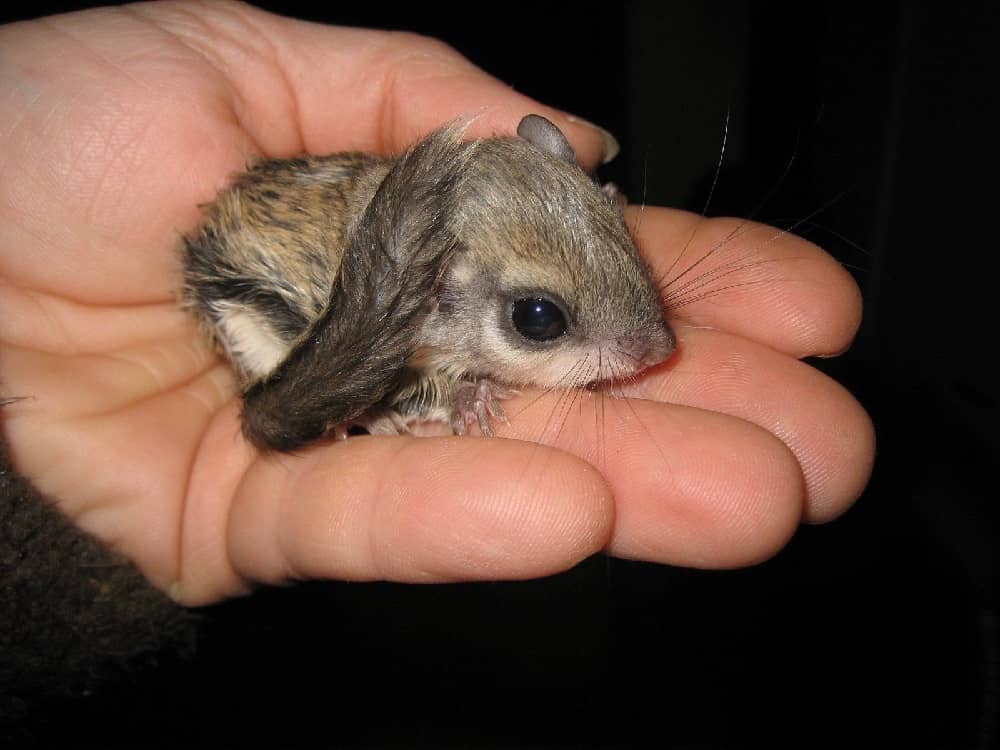
Breeding southern flying squirrels in captivity involves careful planning and preparation. Create a large and enriching atmosphere that reflects their natural habitat. A multi-level cage with lots of climbing space and nesting materials is required. Both breeding males and females should be in good condition and fed a balanced diet.
A proper diet promotes reproductive health and the production of healthy children. Regular veterinarian examinations are required to guarantee the health of the breeding pair and their children.
Similar pets to Southern Flying Squirrel
The species related to The Southern Flying Squirrel are:
- Sugar Glider (Petaurus breviceps)
- Northern Flying Squirrel (Glaucomys sabrinus)
- Greater Glider (Petauroides volans)
- Scaly-tailed Flying Squirrel (Idiurus macrotis)
- Guinea Pig (Cavia Porcellus)
A Southern Flying Squirrel vs. A Sugar Glider
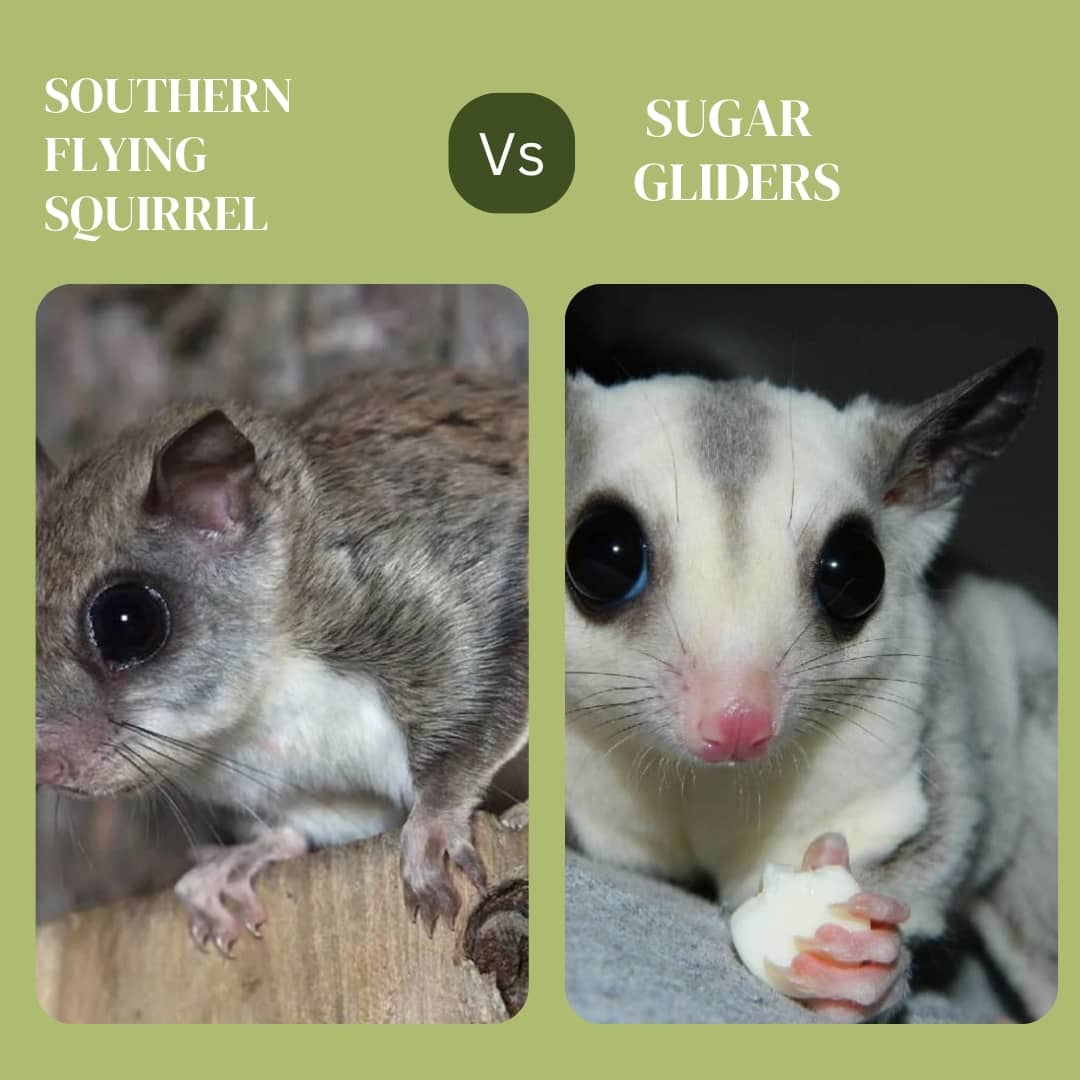
When comparing the Southern Flying Squirrel to the Sugar Glider, it’s fascinating to explore their unique traits and habitats.
| Southern Flying Squirrel | Sugar Glider |
| Native to the southeastern United States. | Native to Australia, New Guinea, and parts of Indonesia. |
| Smaller, typically around 8–10 inches in length, including the tail. | Larger, with an average length of 12–16 inches, including the tail. |
| The patagium extends from wrist to ankle, enabling glides between trees but generally for shorter distances. | The patagium extends from wrist to ankle as well but is broader, allowing for longer and more controlled glides. |
| Primarily eats nuts, fruits, insects, and occasionally bird eggs. | Prefers nectar, fruits, insects, and sometimes small vertebrates. |
| Produces softer, less varied vocalizations | Known for a wide range of vocalizations, including barking, chirping, and chattering. |
| Prefers deciduous and mixed woodlands, particularly areas with mature trees and dense canopy cover. | Favors a variety of forested habitats, including rainforests and woodlands. |
| Breeding occurs once or twice a year, depending on the region. | They may breed throughout the year, with some variation based on their location and environmental conditions. |
Interesting Facts About a Southern Flying Squirrel
- These squirrels are primarily nocturnal, meaning they are active during the night and sleep during the day.
- Their big eyes are designed to see in low light, which aids in their ability to travel in the dark.
- Southern flying squirrels can glide for up to 150 feet (45 meters) because of a unique membrane called the patagium, which extends from their wrists to their ankles.
- The big paws aid them by allowing them to land on trees while gliding. Before the ‘flight’, they normally find the highest point and continue gliding.
- A single individual of this species hoards up to 15,000 nuts during a season.
- They communicate with each other using a range of vocalizations, including high-pitched squeaks, chirps, and clicks.
- They prefer wooded habitats with mature trees, where they build nests in tree cavities or dense foliage.
- In colder climates, southern flying squirrels enter a state of torpor during the winter months.

Frequently Asked Questions
Question 1: Are southern flying squirrels the same as sugar gliders?
Answer: Southern Flying squirrels are from the order Rodentia while sugar gliders are marsupials. They both have gliding capabilities and look alike.
Question 2: How can I tell if a southern flying squirrel is sick?
Answer: Southern flying squirrels show signs of disease such as tiredness, loss of appetite, atypical droppings, fur loss, and difficulty gliding. If you observe any of these symptoms, contact a veterinarian who has experience with exotic pets.
Question 3: Can you keep southern flying squirrels with other pets?
Answer: It is best to keep southern flying squirrels as solitary or mixed-species pets. When the squirrel and the other animals are exposed to other pets, it could be upsetting or even hazardous for them.
Question 4:How do southern flying squirrels stay warm in winter?
Answer: They curl up in their nests, which are lined with fur, leaves, and other insulating materials, in addition to entering into energy-saving torpor. This communal nesting allows them to preserve body heat.
Question 5: Are Flying Southern squirrels good pets?
Answer: When purchased young and raised by their owner, flying squirrels make devoted pets, much like sugar gliders. However, flying squirrels are rodents and require veterinarian treatment particular to their species, unlike sugar gliders.
Conclusion
Southern flying squirrels are an amazing species, with distinct adaptations and intriguing habits. They are a fascinating subject for study and admiration because of their complex social structures, varied diet, and graceful flying over the woods. It is essential to comprehend their needs and behaviors, both in the wild and in captivity, to ensure their survival and to recognize their role in the ecosystem.

